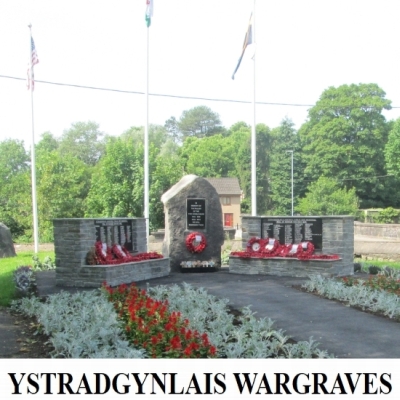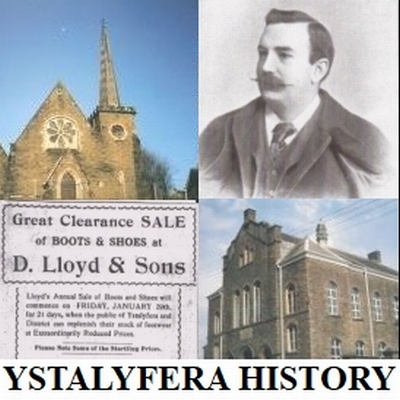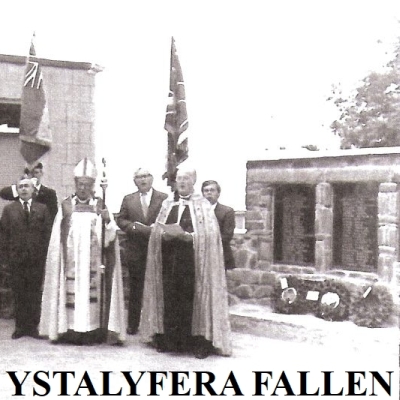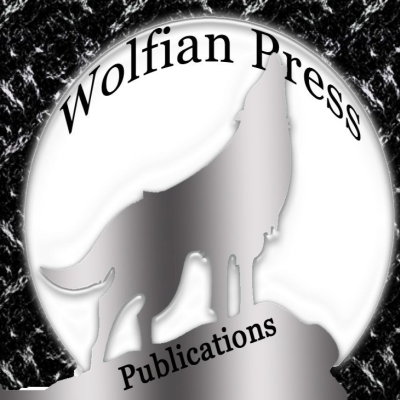James Gough Aubrey
1720-1796
James Gough, as he was when born, was baptised in Chepstow church on 23rd August 1720, implying a date of birth in the months June to August of that year. Chepstow is only 8 miles from the Gough family's estates in Saint Briavels, Gloucestershire, but it does raise the question of why he was baptised there, rather than at Saint Briavels church where most of the Gough family were.
James was the second son of William Gough (snr) who in 1717 had married Catherine Portrey, the eventual heir to the Ynyscedwyn estates. By the mid 1740s this succession was clearly understood, with James' older brother Richard living with his uncle, Christopher Portrey, at Ynyscedwyn House, Ystradgynlais as his heir.
On 10th August 1758, James Gough was appointed Curate at Coelbren Chapel, a subsidiary of Ystradgynlais church, whose rectorship was at that time held by John Seys, appointed in 1742, presumably by Christopher Portrey who would have held the advowson of Ystradgynlais, the right to appoint the rector, until it was alienated, possibly into a trust, in 1751 (Ynyscedwyn estate paper D/D Yc 560-561).
James' elder brother, Richard, acceded to the Ynyscedwyn estates in December 1752, upon the death of Christopher Portrey, though the Ynyscedwyn estate papers infer that the debts of Christopher Portrey's elder brother Richard Portrey were still a problem, and how much Richard Gough Aubrey, as he now took the name, had to enjoy in his inheritance is unclear. The will of Richard Gough Aubrey, written in April 1758, and proved after his death in February 1759, devised "all his real and personal estate" to James.
It can be assumed that it was at this point that James took on the additional surname of Aubrey, becoming James Gough Aubrey. He married Elinor (Eleanor) Williams, of the Williams family of Aberpergwm, Glynneath, in 1761, and by 1775 is being described in the estate papers of the Ynyscedwyn archive as "late of Yniscedwin, now of Aberpergwm" implying that he had made his main residence with her family. Aberpergwm estate paper 2482. vtls005026316 ISYSARCHB2 is a 1776 "Lease for 21 years of the capital messuage called Yniskedwin with the demesne lands premises thereunto belonging..." but the description online does not complete, saying to whom it is being leased.
On 24th August 1763, James Gough Aubrey was appointed Rector of Cilybebyll, a position he would hold until his death in September 1796.
In 1775, as outlined in Ynyscedwyn estate paper D/D Yc 542, James Gough Aubrey signed what is described as "Mortgage (Lease and Release" for £2,000 to to Archibald Drummond of Rudgway, Stapleton, Gloucestershire and covering the main Gough residence of Willsbury and its attendant fields and estates. This is strangely in conflict with D/D Yc 541 which Deed of Limitation seemed to have settled those lands on his brother William Gough, his widow, and then his sons.
Reverend James Gough Aubrey was formally appointed Rector of Ystradgynlais on 12th March 1781. In 1784, he would cause to have created an inscribed marble plaque to hang inside the church, remembering his Portrey and Gough antecedents.
Len Ley in his book 'The Iron Cradle' references Volume 3 of the Aberpergwm Papers showing an agreement between James Gough Aubrey and John Parsons on 28th October 1788. This looks to be the equivalent of Ynyscedwyn estate paper D/D Yc 626, dated 21st October 1788 between James Gough Aubrey and Richard Parsons, referencing the latter's sons Richard and John. By this agreement Parsons got the right to extract iron ore and run the furnaces at Ynyscedwyn. 'The Iron Cradle' implies that this included Ty Coch, but the corrollary paper in the Ynyscedwyn papers explicitly states "the Red house, in occupation of Isod John and son William excepted". This agreement is understood to be the start of the ironworks' life as a major industrial force in the town.
James Gough Aubrey died on the 17th September 1796, aged 76. He was buried beneath the chancel in the old church at Ystradgynlais.
- Gough Family History
- - - William Gough (1722-1760)
- - - Richard Gough Aubrey
- Wedding of 1867
- Yniscedwyn House
- Graves in St. Cynog's
- Belton, Uppingham
- Gough Memorial Windows
- Vicars of Ystradgynlais
- - - Rev. Fleming Gough
- - - Rev. Walter Jones Williams
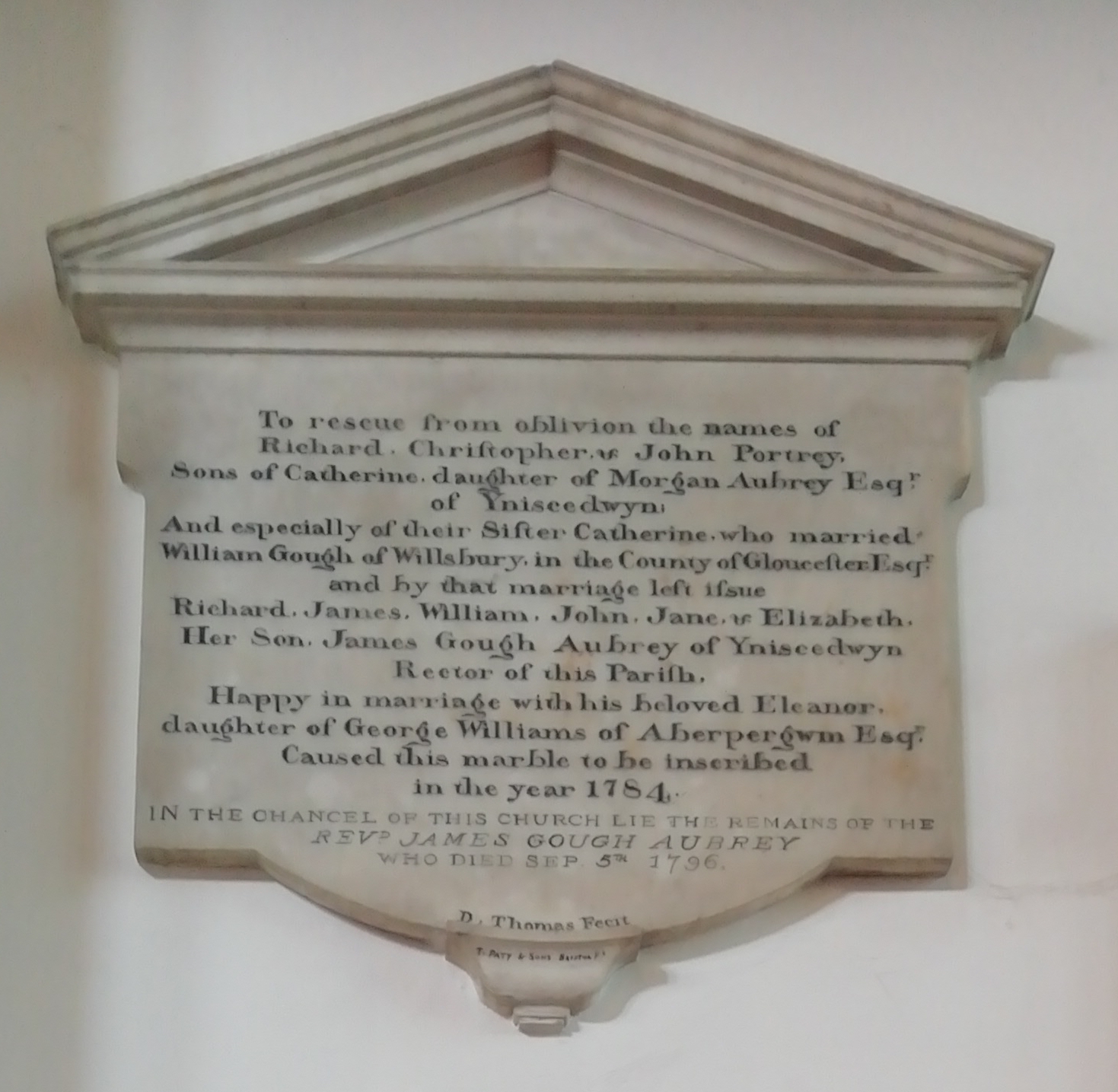
The main memorial to James Gough Aubrey in Saint Cynog's Church, Ystradgynlais. Note that the Portrey descent mentioned at the top is incorrect, as it misses out Christopher senior, who is a generation in between. Also, whilst the children of Catherine Portrey and William Gough on this memorial have been repeated by historians from Theophilus Jones onwards, the identity of John and Jane remain mysterious, if not completely erroneous.
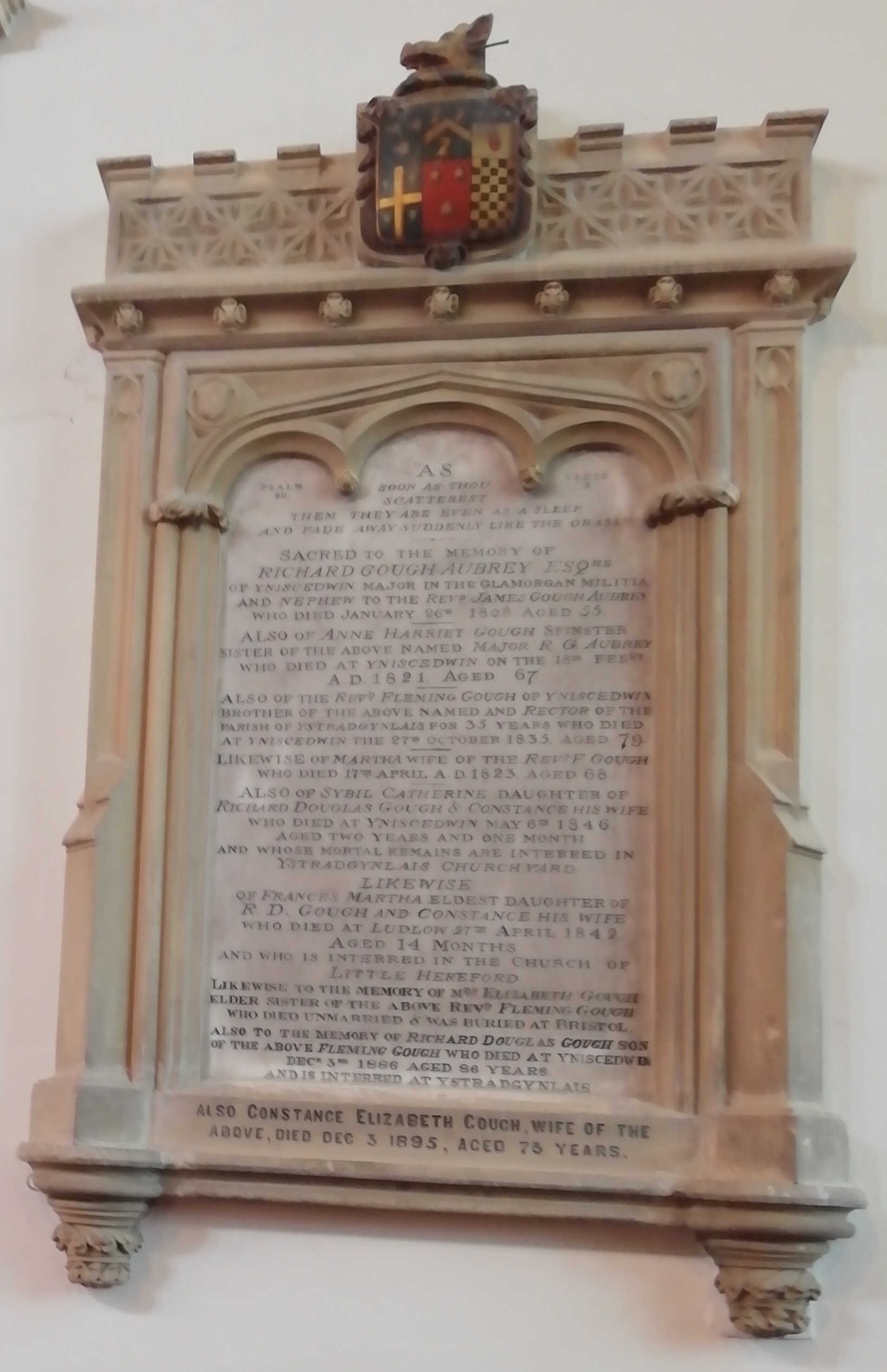
This memorial in Saint Cynog's Church, Ystradgynlais, lists the Gough family from brothers Richard Gough Aubrey, who died childless, and Rev Fleming Gough, both of whom were nephews of the Rev James Gough Aubrey, being sons of his younger brother William.
Church Career
James Gough Aubrey
We do not currently know where James Gough, as he would have been called at the time, was first ordained. Born in 1720, it is probable that he held some minor roles before he was appointed to a position in South Wales. It should be noted that the Clergy of the Church of England website has absent records for Saint Briavels, his family home, from the 1680s to the 1800s, and he may have been first appointed as a curate there. A direct search of the church records may be possible, as they have clearly been digitised to record the baptisms, marriages, and burials, but they are not indexed by curate. It is also possible he may have been appointed to a different, neighbouring, church since the Goughs held several different houses in their estates.
On 10th August 1758, James Gough was appointed Curate at Coelbren Chapel, a subsidiary of Ystradgynlais church, whose rectorship was at that time held by John Seys, appointed in 1742, presumably by Christopher Portrey who would have held the advowson of Ystradgynlais, the right to appoint the rector at that time. Listed as curates appointed immediately preceding him at Coelbren are Herbert David in 1747 and Joshua Jones in 1754. Neither are listed at the Clergy of the Church of England database as either resigning or vacating, nor is there a Liber Cleri listing currently extant clergy for the bishop for any year. It is possible one or other was still there, at the same time, or perhaps more possible that the appointments are sequential and that James Gough replaced Joshua Jones who had replaced Herbert David.
After the death of his elder brother, Richard Gough Aubrey, in February 1759, his will left everything to James. From that point on he would have become known as James Gough Aubrey. He was certainly bearing the name when appointed as Rector of Cilybebyll on 24th August 1763. It should be noted that he continued to hold the curacy of Coelbren chapel at the same time. Coelbren, being a subsidiary of Ystradgynlais, was in the Diocese of Saint David's, whilst Cilybebyll, lying within Glamorganshire, was in the Diocese of Llandaff.
Reverend James Gough Aubrey was formally appointed Rector of Ystradgynlais on 12th March 1781. In 1784, he would cause to have created an inscribed marble plaque to hang inside the church, remembering his Portrey and Gough antecedents.
He continued to hold all three clerical positions until his death, though an additional curate, Morgan Jones, was appointed to Coelbren on 26th September 1788. This would be because James, now Rector of Ystradgynlais, as well as of Cilybebyll, would have devolved duties to someone else for Coelbren, at least a fair amount of the time, although it would have been the chapel nearest to his residence at the Williams estate of Aberpergwm, in Glynneath.
James Gough Aubrey died on the 17th September 1796. In doing so, of course, he vacated the three clerical positions he held.
The Clergy of the Church of England database seems to recall two appointments as curate to Coelbren in quick succession, John Morgan on 14th June 1797 (appointment) and on the 3rd July 1797, licensing, when his patron is listed as Flemming [sic] Gough, Rector of Ystradgynlais. This position was for Perpetual Curate, and on the 31st October 1797 John Jones was also appointed curate.
On the 31st January 1797, Rev Fleming Gough was appointed as Rector of Cilybebyll, his patron in doing so listed as King George, i.e. the crown.
As can be seen from the appointment of the Perpetual Curate of Coelbren, Rev Fleming Gough took over as Rector of Ystradgynlais in at least early 1797. We do not currently have any dates for his appointment, or formalisation of his appointment.
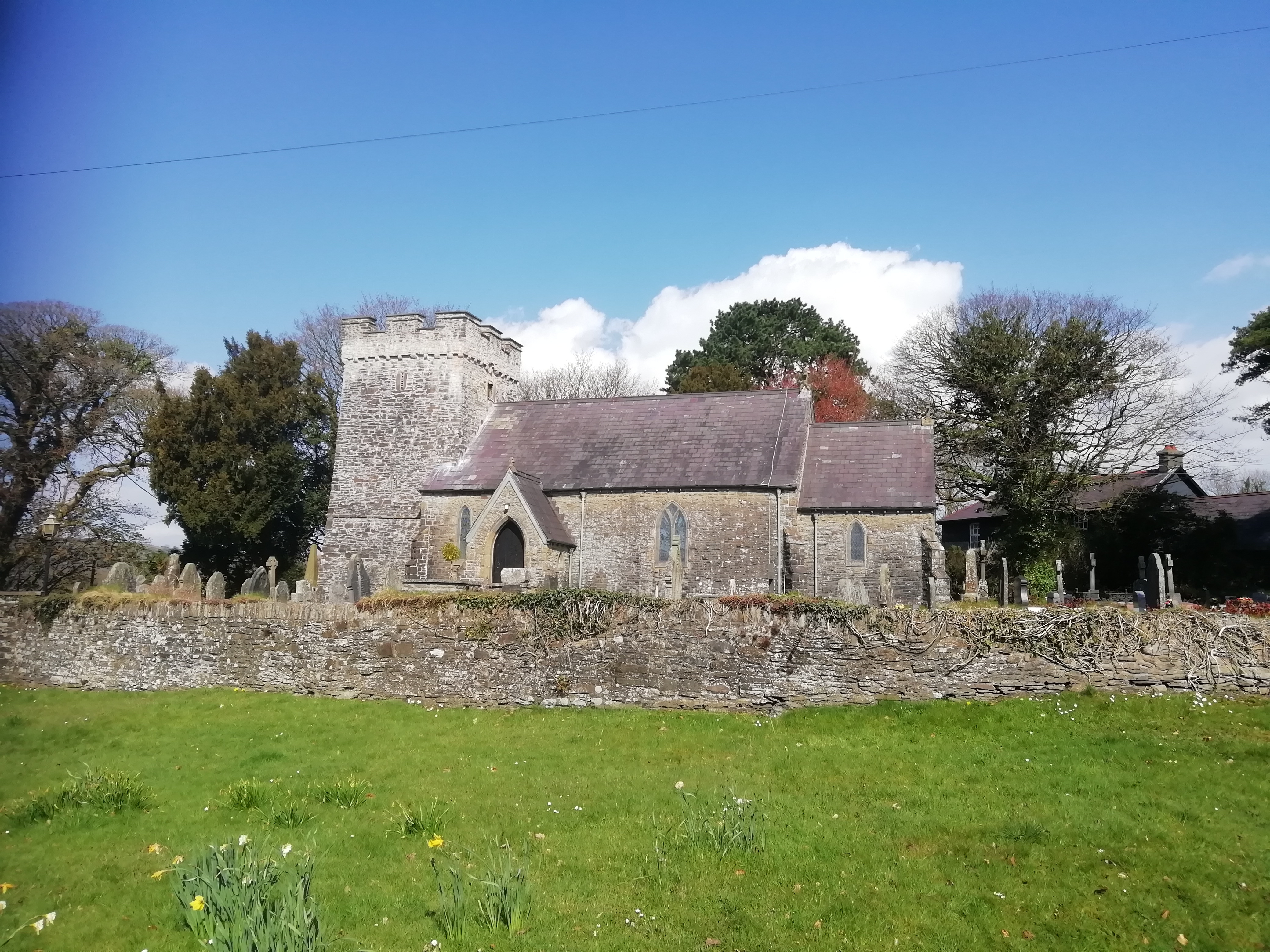
Cilybebyll Church, where the Reverend James Gough Aubrey was Rector from 1763 to 1796
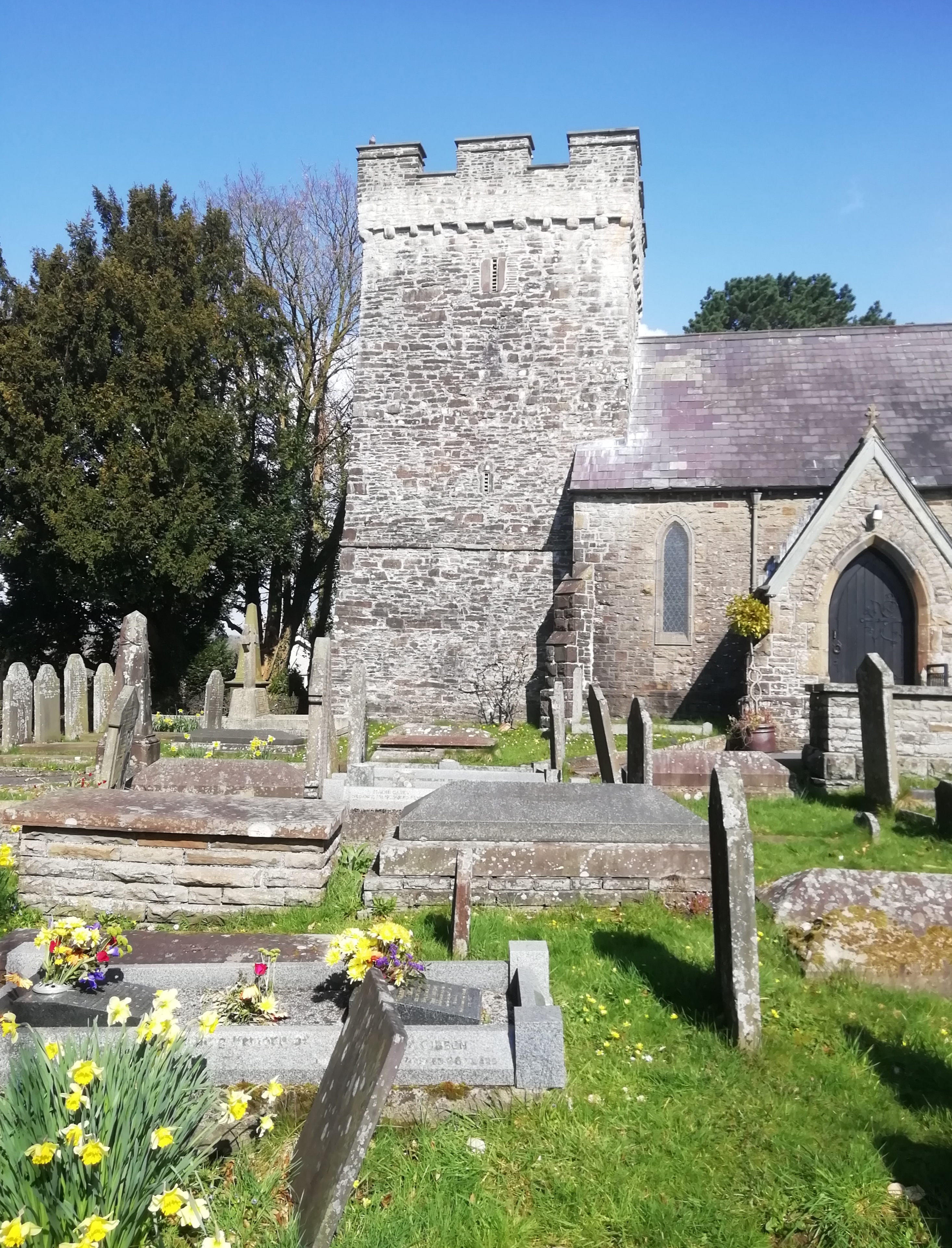
View across the graveyard towards Cilybebyll Church. How different would this have looked in James' time?
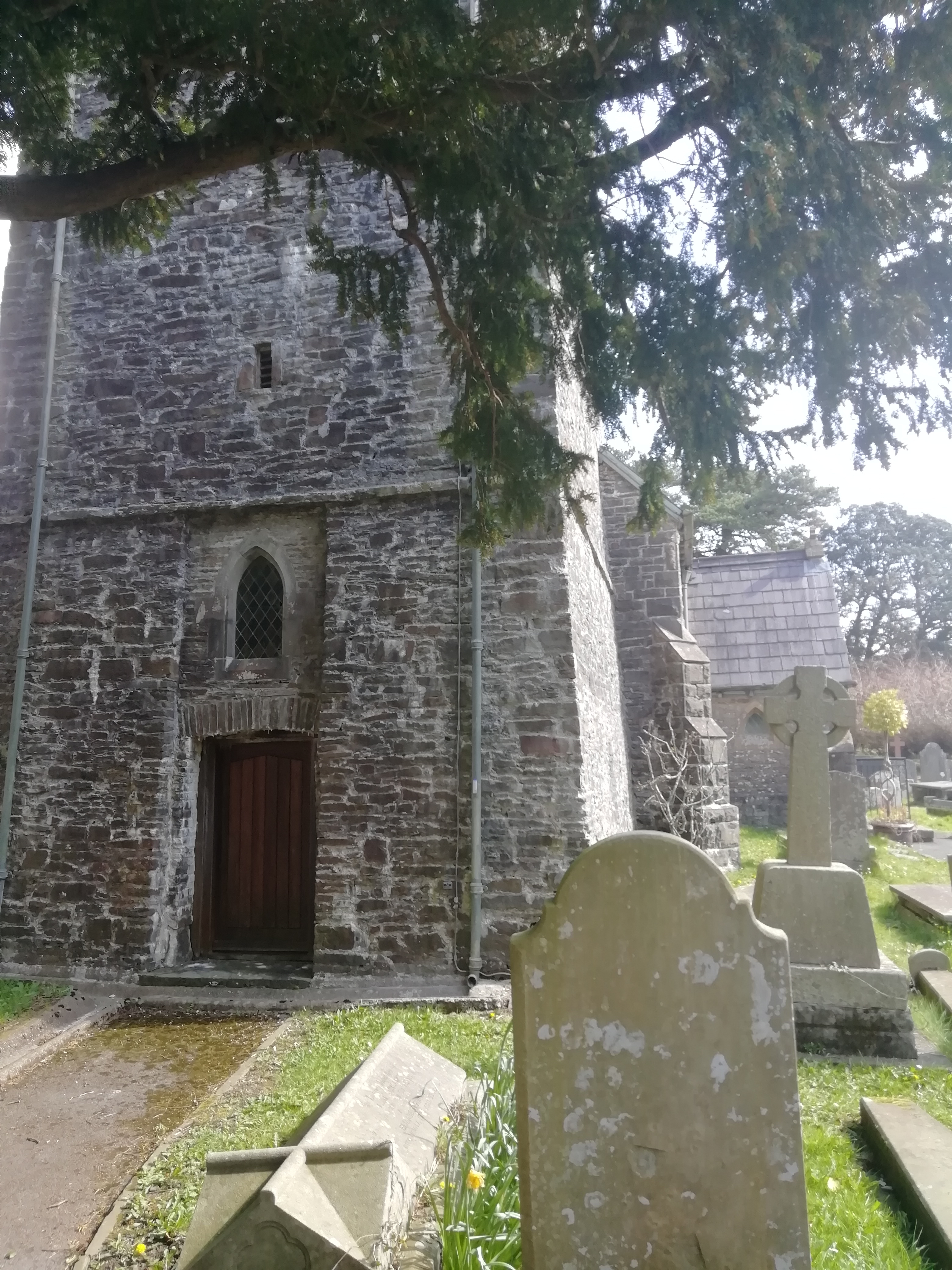
The tower of Cilybebyll Church would certainly have looked not that much different in the late 18th century.
Family Life
Ynyscedwyn and Aberpergwm
James Gough Aubrey married Elinor Williams on 2nd February 1761 at Cadoxton, as proved by the church record, though one source says 20th January 1761. She was the daughter of George Williams of Aberpergwm House, Glynneath.
While James and Elinor did not have any children, both his will and the Ynyscedwyn estate papers make it clear that he was very close to his sister Elizabeth and her children.
Elizabeth was the only surviving daughter of William Gough (snr) and Catherine Portrey, and was born in early 1728, being baptised on 30th April of that year. She married William Lucas on the 16th March 1753, and they had at least three children - Barbara Ann Lucas, born in 1758, James Owen Lucas, and William Lucas.
The Ynyscedwyn estate papers contain quite a few property agreements for Elizabeth, by the mid 1760s a widow, and her daughter Barbara Ann. Barbara Ann didn't marry until she was 37, when she wed John Laugharne Popkin on 25th January 1796, and it is possible that James Gough Aubrey thought that, like his brother William's daughters, she never would do so and was making arrangements for her long-term financial upkeep.
We don't have a date of death for his sister, the widow Elizabeth Lucas. She last appears in the Ynyscedwyn estate papers in c1788, but she is mentioned in James' will, proved in 1797, but written in 1793, when he refers to her "as my poor sister".
Barbara Ann Popkin, as his niece now was, would have at least three children with her husband, and would live until the age of 94, continuing to appear in the Ynyscedwyn estate papers of successive squires of Ynyscedwyn until her death on 8th November 1852.
Eleanor's Family
Eleanor Williams of AberpergwmGeorge Williams, the elder, of Aberpergwm was born in 1714, and died in 1796. He married Catherine Davies and had several children, eldest amongst them George Williams, the younger. Two other sons, Richard (Dicky) and William (Billy) died before 1774.
Eleanor was the eldest of the three daughters of George Williams, the elder, being born in 1740 and known fondly as Nelly. Her younger sisters were Elizabeth and Jane. When George Williams, the younger, died in 1774 without any legitimate children he left everything to his sisters in his will, including to Eleanor and her husband, James Gough Aubrey, whom she had married in 1761.
Eleanor's sister Jane died prior to 1784 and her other sister Elizabeth died in July of that year.
It is clear from the Aberpergwm papers at the National Library of Wales that James Gough Aubrey, acting either in lieu of his elderly father-in-law, or in his own right with Eleanor, is managing the Aberpergwm estate by at least the late 1780s.
Had James and Eleanor had children it seems likely that they would have inherited the united estates of the Goughs of Willsbury, the Ynyscedwyn estate, and the Aberpergwm estate.
George Williams the elder died in 1796, as did the Reverend James Gough Aubrey. I am not sure who died first, but given that James died in September it is possible that George predeceased him.
James Gough Aubrey's will left the estate to Eleanor, with a comment that he had hoped to be leaving her more. It is probable, from law suits entered into by Richard Gough Aubrey and Reverend Fleming Gough that James attempted to leave at least some of the Ynyscedwyn estate to her.
Eleanor died in September 1800. Aberpergwm would be inherited by Rees Williams, an illegitimate descendant of George Williams, the younger.
Managing the Estate
Ynyscedwyn, Willsbury & Aberpergwm
Ynysecedwyn
James Gough Aubrey inherited the Ynyscedwyn estate upon the death of his elder brother, Richard Gough Aubrey, in February 1759, whose will left everything to him. By an act of parliament the estate was under a trust, and James got himself onto the trust, as noted in one of the Gough papers which has ended up in the Aberpergwm archive at the National Library of Wales.
Willsbury
James Gough Aubrey sold the Willsbury estate in Gloucestershire to Thomas Evans in 1791. How this came about will take some understanding.
The Deed of Limitation of 31 May 1758 (D/D Yc 541) is William Gough, senior, settling Willsbury first onto his third son William Gough, junior, then to his wife Christiana, her brother Hezekiah Fleming and one William Jones for 21 years in a trust for the children of William and Christiana, and then to Richard Gough (their eldest son) and heirs in tail.
Willam Gough, junior, dies in 1760 on board his ship, the Penzance at Quebec. But there is no record I can see abrogating the trust that would have come into effect upon this eventuality.
On 20 April 1775, James Gough Aubrey leases out the entirety of the Willsbury estate to Archibald Drummond (D/D Yc 542). His father, William Gough, senior, had died in December 1773 and may well have been living at Willsbury until his death. But the trust referred to above should still have been in effect for 21 years after the death of William Gough, junior, which would have taken it to 1781. Had James got himself placed on the trust, had the trust deferred to him, had it been wound up somehow, or was he simply able to ignore it?
Ynyscedwyn estate paper D/D Yc 544, of February 1791, appears to be the one in which James Gough Aubrey sells Willsbury to Thomas Evans, although the language used in it makes it unclear that this is what is happening.
Aberpergwm
James Gough Aubrey appears to have managed the estate at Aberpergwm, home of the Williams family, as well as that at Ynyscedwyn. I am not certain, but it would seem that the will of George Williams the younger (1774) leaves the Aberpergwm estate to his sisters - Jane Williams, Elizabeth Williams, and Eleanor, the wife of James Gough Aubrey.
Certainly, file with reference code 2195 in the Aberpergwm papers at the National Library of Wales has James and Eleanor leasing out Williams family property, viz: "Lease for 63 years of veins, mines of iron stone and iron ore in, upon or under the capital demesne lands called Aberpergwm"
DATA
DATA
DATA
Mining and Minerals
PLACE LOCATION

DATA

DATA

DATA

DATA

DATA

DATA

DATA
Sources and Useful Information
Online Resources for Historians & Genealogists
Ynyscedwyn Estate Papers (held at West Glamorgan Archive Service)
https://archiveshub.jisc.ac.uk/search/archives/95dd982a-7943-30b7-83bc-e615e82f6ba5
Clergy of the Church of England Database (Up to 1835)
https://theclergydatabase.org.uk/
Forest of Dean Family History Trust (Free Registration)
https://forest-of-dean.net
Dictionary of Welsh Biography
https://biography.wales/
Ancestry (Requires Subscription, available monthly) https://www.ancestry.co.uk/
Free BMD - Births, Deaths and Marriages (from 1837 onwards)
https://www.freebmd.org.uk/
Welsh Newspaper Archive (1804-1919)
https://newspapers.library.wales/home
British Newspaper Archive, from the British Library (subscription necessary):- https://www.britishnewspaperarchive.co.uk
National Archives Discovery website:- https://discovery.nationalarchives.gov.uk/
Aberpergwm papers in the West Glamorgan Archive Service
https://archiveshub.jisc.ac.uk/search/archives/e80af07b-7508-340f-9278-ab5abbbe8169
Aberpergwm papers at the National Library of Wales
https://archives.library.wales/index.php/aberpergwm-estate-records
